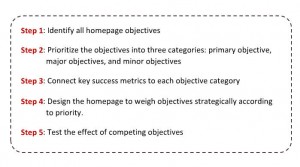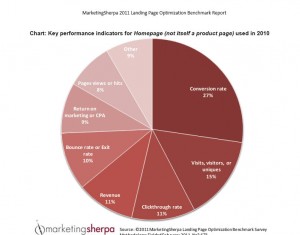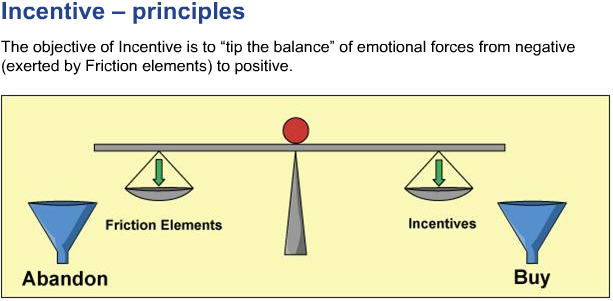Landing pages get a lot of love. Here at MarketingSherpa and MarketingExperiments we often write about landing page optimization, and offer case studies on how marketers are testing and improving landing page performance. And landing pages deserve all that attention because often those pages are the direct connection between a marketing campaign and a closed deal. We think so highly of landing pages at MarketingSherpa we just released a publication dedicated to LPs — the 2011 Landing Page Optimization Benchmark Report.
The homepage is a channel, not a destination
But because landing pages command so much real and virtual ink, the homepage can seem neglected. The first thing to consider is the homepage is unique to a website. For companies that only offer one product or service, the homepage may be no different than a landing page.
But companies with many products, services, divisions, etc., must look at homepages as a drastically different animal than a landing page. Unlike the landing page where you want to get website visitors to the LP, the homepage is channel where your goal is to get the visitor through the page.
The homepage is possibly the toughest page on a website to test because it “serves many masters” and typically has multiple objectives to achieve.
The usual elements in a homepage to test do overlap with landing pages:
- Eye path direction
- Strength of value proposition
- Color combination
- Image relevance
And testing a homepage involves five basic steps:

Click to enlarge
You may notice one word features prominently in each step — objectives. Homepage objectives should be broken into three categories:
- Primary — these are long-term and should have high revenue potential
- Major — short-term and are typically tied to a marketing campaign or other internal need
- Minor — functionally necessary elements to the page such as navigation or legal copy
Taking a closer look at homepages, how they differ from landing pages and how tricky they are to actually test and optimize, caused one chart from the Landing Page Optimization Benchmark Report to really stand out.

Click to enlarge
Boris Grinkot, Associate Director of Product Development, MECLABS, is the author the Landing Page Optimization Benchmark Report and he took a few moments to share his thoughts on homepage optimization and metrics.
Before we get into the questions, here’s a quote from the report (I highlighted the final sentence):
A critical issue becomes the quality of the traffic that the homepage sends into the website. The quality of the traffic is broadly the degree of match between the visitor and the offer – in other words, the predisposition to convert. Reducing bounce rate may be a short-sighted key metric if more visitors get through, yet those are not the visitors that would ever be interested in becoming customers. Dedicating significant page real estate to a $10 gift card offer can explode the clickthrough rate (and conversely, minimize bounces), but it may turn away visitors exploring a multimillion dollar RFP.
In your LPO Benchmark Report, you mention the homepage is possibly the most difficult page for designing a test …
Boris Grinkot: Measurement on the homepage is complicated because so many things typically happen between it and the conversion step. The general point is that when looking at the funnel holistically, a test on the homepage can affect different metrics differently, and sometimes you can get contradictory results — bounce rate reduced = good, conversion rate reduced = bad.
The homepage as any entrance page acts as a filter, and changing it does not only linearly affect clickthroughs to the rest of the funnel, but can affect the quality of visitors that click through — in other words, the segments.
So, what metrics are most important when testing a homepage?
BG: It’s important that marketers monitor several different metrics to get a complete picture of what’s going on. Bounce rate or clickthrough rate measures what happens immediately on the homepage, or wherever it’s measured, but misses how this page affects the rest of the funnel. Overall conversion rate (CR) measures performance of the site as a whole, but ignores where the leaks might be.
More intricate measurement — such as using “active segments” or “goals” — can tell you what happens with visitors who viewed a particular page, meaning that a virtual segment is created based on what the visitor experienced. Segment-specific CR can be much more meaningful because it takes specific page(s) into account.
Boris Grinkot will be providing insights from his Landing Page Optimization Benchmark Report and moderating a panel on “Overcoming institutional barriers to optimization implementation” at the first MarketingSherpa Optimization Summit coming up June 1-3 in Atlanta.
Related Resources
Homepages Optimized web clinic
Homepage Optimization: How sharing ideas can lead to more diverse radical redesigns
Homepage Optimization: How a more logical eye-path led to 59% increase in conversions
Homepage Optimization: Radical redesign ideas for multivariable testing
B2C Testing: A discount airline looks to increase conversion
(Members library) — Office Depot Site Overhaul Lifts Conversions 10%: 7 Tactics to Target High-Impact Improvements
 I think it goes without saying that online shopping is no longer just a convenient option for consumers. It’s a retail mainstay, and a key to holiday marketing success.
I think it goes without saying that online shopping is no longer just a convenient option for consumers. It’s a retail mainstay, and a key to holiday marketing success.










